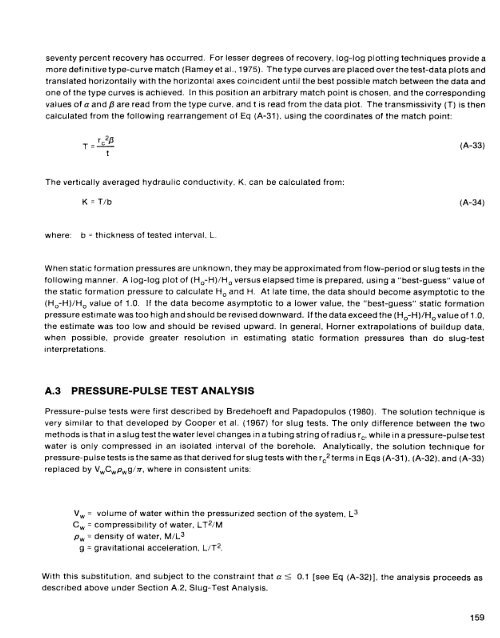Beauheim 1987 - Waste Isolation Pilot Plant - U.S. Department of ...
Beauheim 1987 - Waste Isolation Pilot Plant - U.S. Department of ...
Beauheim 1987 - Waste Isolation Pilot Plant - U.S. Department of ...
You also want an ePaper? Increase the reach of your titles
YUMPU automatically turns print PDFs into web optimized ePapers that Google loves.
seventy percent recovery has occurred. For lesser degrees <strong>of</strong> recovery, log-log plotting techniques provide a<br />
more definitive type-curve match (Ramey et al., 1975). The type curves are placed over the test-data plots and<br />
translated horizontally with the horizontal axes coincident until the best possible match between the data and<br />
one <strong>of</strong> the type curves is achieved. In this position an arbitrary match point is chosen, and the corresponding<br />
values <strong>of</strong> a and p are read from the type curve, and t is read from the data plot. The transmissivity (T) is then<br />
calculated from the following rearrangement <strong>of</strong> Eq (A-31), using the coordinates <strong>of</strong> the match point:<br />
(A-33)<br />
The vertically averaged hydraulic conductivity. K, can be calculated from:<br />
K = T/b<br />
(A-34)<br />
where: b = thickness <strong>of</strong> tested interval, L.<br />
When static formation pressures are unknown, they may be approximated from flow-period or slug tests in the<br />
following manner. A log-log plot <strong>of</strong> (H,-H)/H, versus elapsed time is prepared, using a "best-guess" value <strong>of</strong><br />
the static formation pressure to calculate H, and H. At late time, the data should become asymptotic to the<br />
(H,-H)/H, value <strong>of</strong> 1.0. If the data become asymptotic to a lower value, the "best-guess'' static formation<br />
pressureestimate was too high and should be revised downward. If thedataexceed the (H,-H)/H,value <strong>of</strong> 1 .O,<br />
the estimate was too low and should be revised upward. In general, Horner extrapolations <strong>of</strong> buildup data,<br />
when possible, provide greater resolution in estimating static formation pressures than do slug-test<br />
interpretations.<br />
A.3 PRESSURE-PULSE TEST ANALYSIS<br />
Pressure-pulse tests were first described by Bredehoeft and Papadopulos (1980). The solution technique is<br />
very similar to that developed by Cooper et al. (1967) for slug tests. The only difference between the two<br />
methods is that in a slug test the water level changes in a tubing string <strong>of</strong> radius rc, while in a pressure-pulse test<br />
water is only compressed in an isolated interval <strong>of</strong> the borehole. Analytically, the solution technique for<br />
pressure-pulse tests is the same as that derived for slug tests with the rc2 terms in Eqs (A-31). (A-32), and (A-33)<br />
replaced by V,C,pwg/n, where in consistent units:<br />
V, = volume <strong>of</strong> water within the pressurized section <strong>of</strong> the system, L3<br />
C, = compressibility <strong>of</strong> water, LT*/M<br />
p, = density <strong>of</strong> water, M/L3<br />
g = gravitational acceleration, L/T?<br />
With this substitution, and subject to the constraint that a 5 0.1 [see Eq (A-32)], the analysis proceeds as<br />
described above under Section A.2, Slug-Test Analysis.<br />
159

















